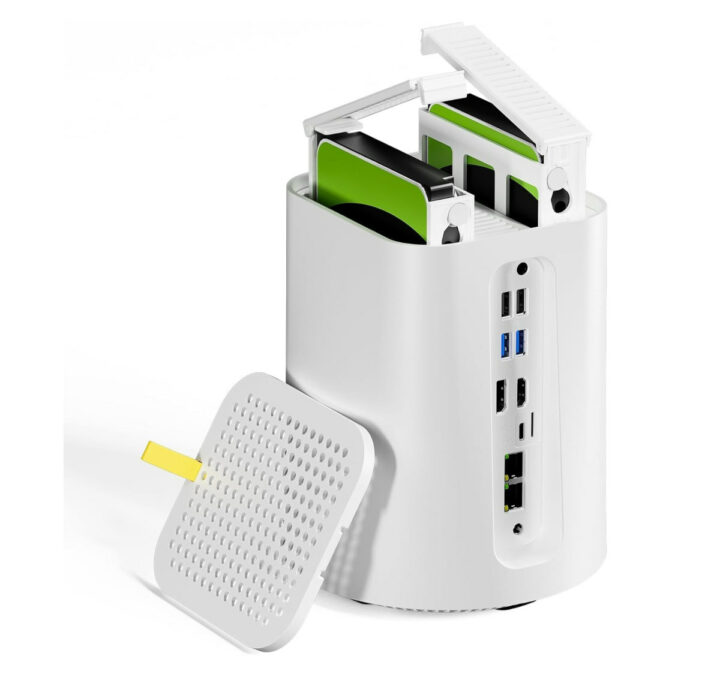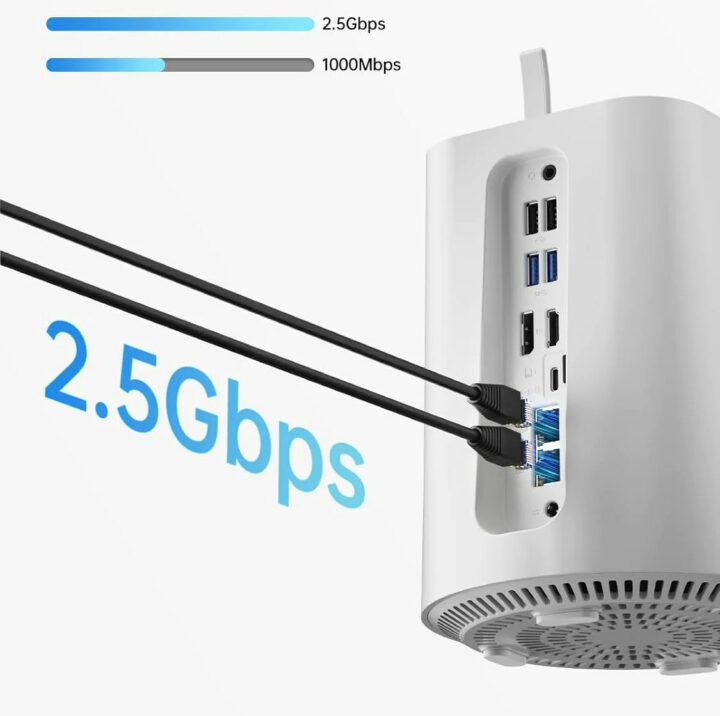AOOSTAR R1 Intel N100 mini PC triples as a 2-bay NAS thanks to two bays for 3.5-inch SATA drives and as a router through two 2.5GbE network interfaces.
It’s a lower-cost version of the Ryzen 5-powered AOOSTAR N1 Pro that was introduced last June. It ships with up to 16GB DDR4 RAM, an optional 512 GB NVMe SSD, offers WiFi 6 and Bluetooth 5.2 connectivity, supports up to three displays via HDMI, DisplayPort and USB-C ports, and comes with five USB ports.
 AOOSTAR R1 (also called WTR R1) specifications:
AOOSTAR R1 (also called WTR R1) specifications:
- SoC – Intel Processor N100 quad-core Alder Lake-N processor @ up to 3.4 GHz (Turbo) with 6MB cache, 24EU Intel HD graphics @ 750 MHz; TDP: 6W
- System Memory – Optional 16GB DDR4-3200 via SO-DIMM socket
- Storage
- Optional 512GB M.2 2280 NVMe SSD
- 2-bay NAS compatible with 2.5-inch or 3.5-inch SATA drives
- MicroSD card slot
- Video Output
- 4Kp60 video output via HDMI 2.0, DisplayPort, USB Type-C port
- Up to 3x independent displays
- Audio – 2-in-1 speaker/microphone jack
- Networking
- 2x 2.5GbE RJ45 ports via Intel i226V controllers
- Dual-band WiFi 6 and Bluetooth 5.2 (AX201 module)
- USB
- 2x USB 3.2 Gen 2 ports
- 2x USB 2.0 ports
- 1x USB Type-C port with support for USB PD, DisplayPort Alt mode.
- Misc – 2x powerful low-noise fans, heatsink
- Power Supply – 19V DC/5.12A (100W) via power barrel jack
- Dimensions – 162 x 162 x 198 mm
- Weight – About 1kg
Compared to the Ryzen version, you are limited to 16GB RAM, and one of the M.2 sockets for NVMe storage is gone, but all other features look the same. So if you don’t need the extra processing power, higher RAM capacity, and/or two M.2 SSDs, the Intel Processor N100 model will be a more cost-effective solution.
The AOOSTAR R1 is available as a barebone system without RAM or storage ($209) or as a complete Windows 11 Pro system with 16GB RAM and a 512GB NVMe SSD ($269). The prices are from the AOOSTAR store with the $50 coupon code (R1N100), but pre-orders should also start on Amazon on October 26. Most people wanting to use the Intel N100 mini PC as a NAS or router will likely prefer going with the barebone model to install the Linux or BSD-based distribution of their choice such as TrueNAS or pfSense, or even the Promox open-source virtualization platform to run multiple operating systems.
Via Liliputing

Jean-Luc started CNX Software in 2010 as a part-time endeavor, before quitting his job as a software engineering manager, and starting to write daily news, and reviews full time later in 2011.
Support CNX Software! Donate via cryptocurrencies, become a Patron on Patreon, or purchase goods on Amazon or Aliexpress





